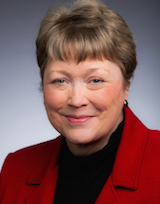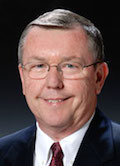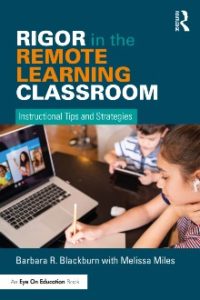Make Sure Virtual PD Works for Teachers
By Barbara R. Blackburn and Ronald Williamson

Barbara
Every school in America has been impacted by Covid-19. Many have moved to an online program while others are either teaching face to face or offering a hybrid of the two.
Through it all, one thing remains constant – the need for professional development. Due to the pandemic most professional learning has moved to a virtual format. And in many cases the need for professional development has increased due to the shift to online teaching and the adoption of new digital learning systems and education apps.

Ron
In order to offer the most effective options for teachers, school leaders should consider three dimensions of professional development moving forward: (1) the purpose, (2) the content, and (3) the delivery platform.
(1) Determine Your Purpose
As you plan your professional development, you will want to be sure that it links to your specific goals. Too often, we’ve seen schools jump on the latest bandwagon, even when it doesn’t link to their school’s focus.
The best way to plan staff development is to assess your goals and needs first, then find professional development that supports them. A critical part of that assessment is to look at your student data to ensure their identified needs are met. If virtual teaching tools are part of that equation, matching needs and tools may be part of your assessment.
Finally, if you’re offering PD to promote new teaching practices, those practices should be research-based. Barbara spoke with a principal recently who was excited about a new initiative for the school. When asked what research it was based on, the principal said, “I know several other schools that are using it, so it must be good.” Effective professional development is based on solid research, not just the latest trend or casual endorsement.
(2) Determine Your Content
The content you provide should be based on your school’s goals as well as teachers’ needs. However, we’d like you to consider another aspect of determining your content: teachers’ needs based on Maslow’s hierarchy. Until we meet teachers’ basic needs, it is difficult to move to the higher levels.
First, teachers, like everyone else, have survival needs. In that level, teachers are concerned with issues such as Do I have the right tools? Am I able to use the technology correctly? Where will I get tech help?
Once those needs are satisfied, you’ll want to turn your attention to security needs. These include Where will I set up my computer for video presentations? How will I balance my work and personal life? Who is deciding how long we will do this?
Third, teachers have belonging needs. In this stage, they ask questions such as How will I work with other teachers? Closely linked to belonging are those related to esteem, such as Will parents think I am a good teacher? Will students think I am a good teacher?
Addressing those needs will allow most teachers to move up the hierarchy to the level of “the need for knowledge.” Teachers are often interested in topics such as What should remote instruction look like? How do I plan a remote lesson? How do you incorporate scaffolding into remote lessons? What are appropriate grading and assessment strategies for remote lessons?
This is the level of Maslow you should focus on in your professional development, but it is important to address safety, security, belonging, and esteem needs first so those concerns don’t overwhelm your PD program.
(3) Determine the Platform
The best staff development is active, rather than passive. Whether they’re sitting in physical training space or sitting at home using Zoom, no one wants to listen to a lecture, being told what he or she is doing wrong, and what he or she should change.
Teachers want professional development that is positive and relevant to their needs, and they want to engage in learning in active ways. It’s interesting to us that we promote active learning for students, but oftentimes we do the opposite for teachers. This is one of the reasons teacher input during PD planning is important, whatever the setting. Teachers are very quick to ask the kinds of questions that can help ensure active learning and relevance.
There are three questions to consider when choosing your platform for professional development.
• What platform(s) do I have access to?
• How does the platform provide interaction and collaboration?
• How does the platform provide follow-up opportunities?
For example, if a grade level, a team, or a department would like to look at student work to determine a common level of rigor or grading standards, you’ll want a platform that allows for full collaboration. One school district used Google Docs to post work samples for review, then teachers met using Google Hangouts to discuss what they learned and any adjustments that needed to be made.
Many districts use book study for their professional development, which allows teachers to share their learning on a common reading. This is one of the easiest professional development opportunities to shift online. Teachers and leaders can read e-books and respond to the book – synchronously and asynchronously – via secure chat boards or blogs and by discussing their reading in live Zoom sessions. If they incorporate strategies in their virtual classroom, they can post short videos or screen shots on a program like Canvas or using apps like Flipgrid.
Finally, you may choose to use a content expert to present information to your teachers. A live presentation using Zoom, Google Hangouts, Skype Meet Now, or Microsoft Teams is ideal, because the presenter can answer questions. You would also want to encourage the use of interactive tools such as breakout rooms (Zoom / Google Meet), polls, and chats so teachers are able to interact throughout the presentation.
A Final Note
As more schools embrace virtual learning for students, we must also address virtual professional development for teachers. By considering our purpose, the content, and the appropriate platforms to deliver content – and engaging teachers fully in our PD planning and assessment – we can assure effective professional learning experiences during times when we must observe social distancing.

An internationally recognized expert in the areas of rigor and motivation, Barbara collaborates with schools and districts for professional development. She can be reached through her website. Follow her on Twitter @BarbBlackburn.
Dr. Ronald Williamson is Professor of Leadership and Counseling at Eastern Michigan University. He was a middle grades teacher, principal, and executive director of instruction in Ann Arbor, MI. He’s also served as executive director of the National Middle School Association (now AMLE) and as president of the National Forum to Accelerate Middle Grades Reform.



































